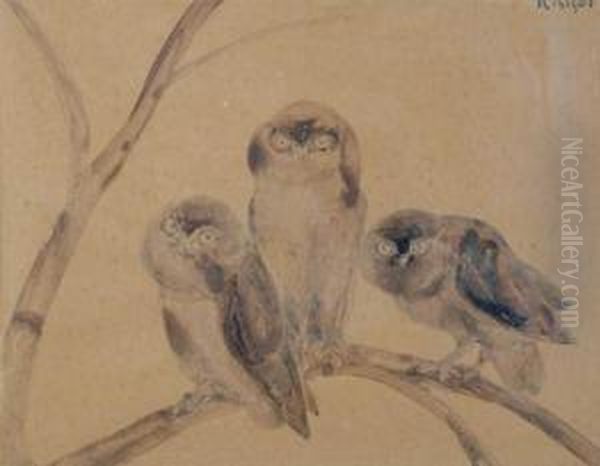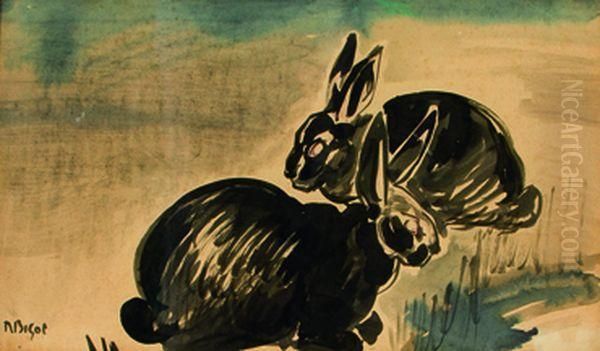Raymond Bigot (1872-1953) was a distinguished French artist whose multifaceted career spanned painting, sculpture, and illustration. Active during a vibrant period of artistic transformation in Europe, Bigot carved out a unique niche for himself, creating works that resonated with both contemporary concerns and timeless themes. His contributions, particularly in sculpture and animal art, reflect a keen observational skill and a deep engagement with the artistic currents of his time, while also demonstrating a distinctive personal vision.
Early Life and Artistic Formation
Born in 1872, Raymond Bigot emerged as an artist in France during the Belle Époque, a period characterized by optimism, artistic innovation, and a flourishing of diverse styles. While specific details of his early training are not extensively documented in the provided information, it is evident that he developed a strong foundation in traditional artistic techniques. This era saw the lingering influence of academic art, the revolutionary impact of Impressionism championed by artists like Claude Monet and Edgar Degas, and the rise of Post-Impressionism with figures such as Paul Cézanne and Vincent van Gogh. Furthermore, Art Nouveau, with its emphasis on organic forms and decorative elegance, was reaching its zenith, exemplified by artists like Hector Guimard and Alphonse Mucha. It was within this rich and varied artistic milieu that Bigot began to shape his creative path.
His decision to pursue multiple disciplines—painting, particularly watercolor, oil painting, and drawing, alongside sculpture, especially wood carving—speaks to a versatile talent and a broad artistic curiosity. This versatility allowed him to explore different modes of expression and engage with a variety of subject matter, though a particular affinity for the natural world, especially animals, would become a hallmark of his oeuvre.
Master of Animal Sculpture and Observation

Raymond Bigot demonstrated a profound understanding and appreciation for animal forms, which he translated into compelling sculptures and drawings. His wood carvings, in particular, showcase a sensitivity to the material and an ability to capture the essence of his subjects. One notable example is the wood carving titled "Les chouettes" (The Owls). This piece, measuring 30 cm in height, 53 cm in length, and 20 cm in width, and signed "R.Bigot," was estimated at auction for between 4,000 and 6,000 euros, indicating its value and appeal to collectors. Another wood carving, "Squirrel," further attests to his skill in this medium and his focus on animal subjects.
His talent for animal depiction was not confined to sculpture. Bigot was also known for his watercolors and drawings, with works like "Deux lapins" (Two Rabbits) and "Un couple de canards" (A Pair of Ducks) appearing in auctions. These pieces highlight his meticulous observation and ability to convey the character and vitality of the animals he portrayed. This focus places him within a strong tradition of animalier art in France, which had seen earlier masters like Antoine-Louis Barye and would include contemporaries such as François Pompon, known for his stylized animal sculptures, and Rembrandt Bugatti, famed for his expressive bronzes of exotic and domestic animals.
Monumental Work: Commemorating National Spirit
Beyond his smaller-scale sculptures and paintings, Raymond Bigot made a significant contribution to public art through his involvement in monumental sculpture. His most prominent work in this domain is the sculptural element for the World War I memorial in Caen, Normandy, titled "Monument aux soldats morts à la guerre" (Monument to the Soldiers Who Died in the War). The overall monument was designed by his brother, the architect Paul Bigot, a respected figure in his own right. Raymond Bigot was responsible for the powerful allegorical sculpture that forms a central part of this commemorative structure.
The sculpture features a dynamic relief of a French rooster triumphantly defeating a German eagle. This potent symbolism—the Gallic rooster being a traditional emblem of France and the eagle representing Germany—encapsulated the French victory and the enduring spirit of resistance during the Great War. Created to honor the sacrifice of French soldiers, this work is a poignant example of how art can serve as a vehicle for national memory and identity. Such war memorials became a common feature across Europe in the aftermath of World War I, with artists like Antoine Bourdelle, a student of Auguste Rodin, also creating significant commemorative works. Bigot's contribution to the Caen memorial remains an important piece of civic art and a testament to his ability to work on a grand, symbolic scale.
Illustrations, Prints, and an Engagement with Japanese Art

The provided information highlights Raymond Bigot's involvement in satirical sketches and print art, suggesting a broader graphic output. He is noted for satirical illustrations, particularly for publications such as The Graphic magazine, where his works often depicted scenes of Japanese life and culture. This interest in Japanese themes indicates an engagement with Japonisme, the influence of Japanese art, culture, and aesthetics on Western art. Japonisme had been a powerful force in European art since the mid-19th century, profoundly impacting Impressionists, Post-Impressionists like Paul Gauguin, and Art Nouveau artists.
Bigot's work in this vein is said to have been influenced by Japanese Ukiyo-e, particularly the Manga of Katsushika Hokusai, showcasing a detailed observation of Japanese culture, flora, and fauna. This suggests that, like many artists of his generation, Bigot was receptive to non-Western artistic traditions and found inspiration in their unique visual language and thematic content. His illustrations for French publications such as FRAISIER-O and PAGES & CROQUES 1894 further underscore his activity as a graphic artist, contributing to the rich visual culture of the period. The satirical nature of some of these works points to a critical engagement with contemporary society, a common role for illustrators and printmakers.
Artistic Style: A Blend of Realism, Satire, and Decorative Sensibilities
Analyzing Raymond Bigot's artistic style requires considering the different facets of his production. In his animal sculptures and paintings, a strong element of realism and naturalism prevails. He meticulously observed his subjects, capturing their anatomical accuracy and characteristic behaviors. This dedication to verisimilitude is evident in works like "Two Rabbits" and "Squirrel."
However, the description of his graphic work introduces other dimensions to his style. The satirical sketches and illustrations depicting Japanese life suggest a capacity for caricature and social commentary. If influenced by Hokusai's Manga, his style in these works might have incorporated dynamic lines, expressive figures, and a keen eye for the details of everyday life, potentially with a humorous or critical edge. The influence of Japonisme could also manifest in compositional strategies, flattened perspectives, or decorative patterning, elements that were absorbed and reinterpreted by many Western artists.
His involvement with the Caen war memorial demonstrates an ability to work in a more heroic and symbolic mode, appropriate for public commemorative art. The style here would likely blend realistic anatomical representation with a heightened sense of drama and allegorical power. It's also plausible that elements of Art Nouveau, with its flowing lines and decorative qualities, might have subtly informed aspects of his work, given its prevalence during his formative and active years. Artists like Gustav Klimt in Austria, for instance, masterfully blended figurative art with rich ornamentation, reflecting a broader European trend.
Context within the Broader Art World
Raymond Bigot's career unfolded during a period of intense artistic experimentation and the co-existence of diverse movements. While he may not be as globally renowned as some of his contemporaries like Pablo Picasso or Henri Matisse, who were forging revolutionary paths in modern art, Bigot's work holds its own distinct value. He operated within established genres like animal art and monumental sculpture, yet he also engaged with contemporary trends like Japonisme and the popular medium of satirical illustration.
His collaboration with his brother Paul Bigot on the Caen memorial places him within a network of artistic and architectural practice where different disciplines converged for public projects. The market for his works, as evidenced by auction records for pieces like "Les chouettes," indicates a continued appreciation among collectors. His animal sculptures connect him to a lineage of French animaliers, while his graphic work aligns him with a tradition of illustration and social commentary that flourished in journals and books of the era.
The mention of his works appearing in publications like FRAISIER-O and PAGES & CROQUES 1894 situates him within the vibrant print culture of late 19th and early 20th century France. This was a time when illustrated journals and books were immensely popular, providing a platform for artists to reach a wide audience. Figures like Théophile Steinlen and Henri de Toulouse-Lautrec also made significant contributions to this field, capturing the spirit of Parisian life in their iconic posters and illustrations.
Legacy and Conclusion
Raymond Bigot (1872-1953) was an artist of considerable talent and versatility. His legacy is preserved through his sculptures, which showcase a mastery of form and a deep empathy for his animal subjects, and through his paintings and drawings that further explore these themes. The Caen war memorial stands as a lasting public testament to his skill in monumental and symbolic art, a poignant reminder of a critical period in French history.
His engagement with diverse artistic modes, from the naturalism of his animal studies to the satirical and Japonisme-influenced style of his graphic work, paints a picture of an artist responsive to the multifaceted artistic environment of his time. While perhaps not a radical innovator in the vein of the avant-garde, Bigot contributed meaningfully to the artistic landscape through his skilled craftsmanship, his keen observational abilities, and his capacity to work across different media and for various purposes, from private collection to public commemoration. His art reflects a dedication to his craft and an ability to capture both the enduring beauty of the natural world and the specific cultural and historical currents of his era. Raymond Bigot remains a noteworthy figure in early 20th-century French art, whose works continue to be appreciated for their skill, sensitivity, and historical resonance.